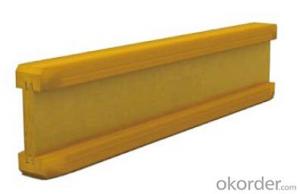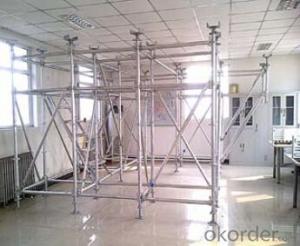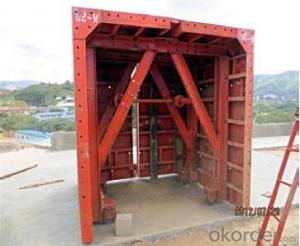Timber- Beam for Formwork and Scaffolding system
- Loading Port:
- Tianjin
- Payment Terms:
- TT OR LC
- Min Order Qty:
- 50 m²
- Supply Capability:
- 1000 m²/month
OKorder Service Pledge
OKorder Financial Service
You Might Also Like
Characteristics:
◆ Standardized production lines.
Supply capability: 3000m/day, Lmax = 6600mm.
◆ Finger jointing of the flange and web, the strength of timber beam is highly improved.
Max. shearing force failure load:40KN
◆ Well treated to prevent from water penetration or erosion, so the service life maximally extended.
Normally, CNBM timber beam H20 can be used for 4 to 5 years, the exact using time would depend on maintenance & storage.
◆ Robust caps at the end of the girders protect against damages.
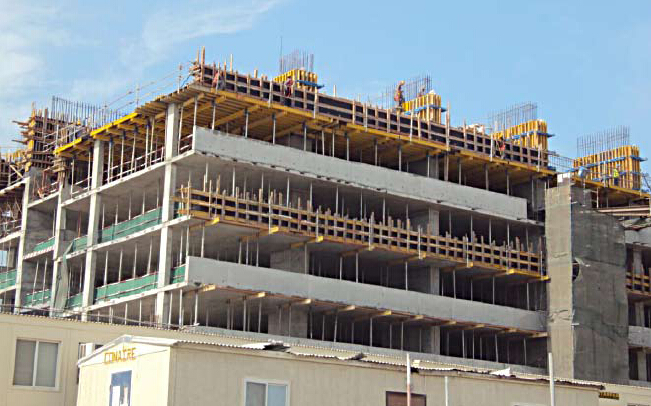
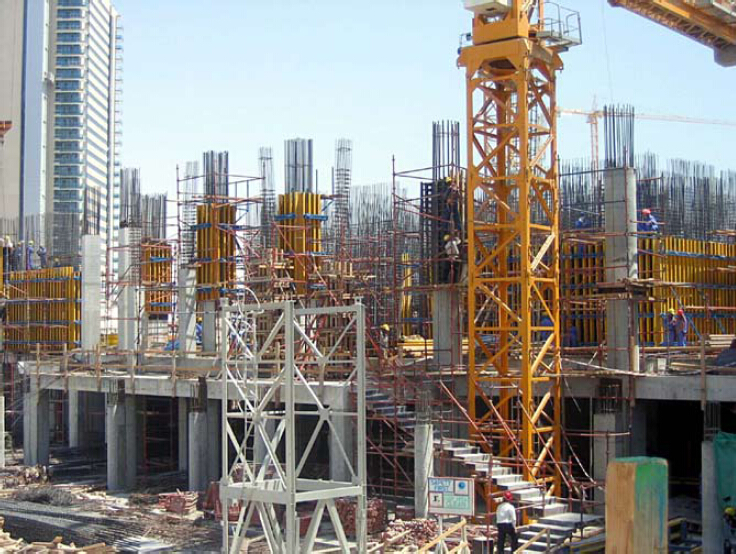
- Q: How does steel formwork handle concrete surface blemishes?
- Steel formwork is a popular choice in construction projects because of its durability and strength. It offers several advantages when it comes to dealing with concrete surface blemishes. To begin with, the smooth and rigid surface of steel formwork helps minimize the occurrence of surface blemishes on the concrete. Unlike timber or other formwork materials that may warp or deform easily, steel maintains a consistent and even surface for pouring the concrete. This reduces the chances of imperfections like air pockets, formwork marks, or uneven textures. Furthermore, steel formwork allows for precise control over the concrete pouring process. The panels are manufactured with high precision, ensuring accurate dimensions and alignment. Tight joints and connections between the panels further minimize the likelihood of concrete seepage or leakage, which can cause blemishes such as honeycombing or efflorescence. Moreover, steel formwork is easy to clean and maintain, which helps prevent or handle concrete surface blemishes. The smooth surface allows for easy removal of excess concrete or debris that may accumulate during pouring. This prevents the formation of unwanted blemishes and preserves the quality of the concrete surface. In situations where concrete surface blemishes do occur, steel formwork has the advantage of being reusable. Unlike other formwork materials that may need to be discarded after a single use, steel formwork can be easily cleaned, repaired, and used again for multiple projects. This provides more control over the quality of the formwork, reducing the risk of surface blemishes in subsequent concrete pours. In conclusion, steel formwork effectively handles concrete surface blemishes by providing a smooth and rigid surface, precise control over the pouring process, easy maintenance and cleaning, and reusability. These features contribute to achieving a high-quality concrete surface with minimal blemishes, ensuring an aesthetically pleasing and structurally sound end result.
- Q: What are the typical sizes and dimensions of steel formwork panels?
- The typical sizes and dimensions of steel formwork panels vary depending on the specific project requirements and construction practices. However, common sizes range from 1.2 meters to 2.4 meters in width and 1.8 meters to 3 meters in height. The thickness of these panels typically ranges from 12 millimeters to 18 millimeters. It's important to note that these dimensions can be customized and adjusted according to the specific needs and design of the construction project.
- Q: How does steel formwork contribute to the overall structural stability of the building?
- Steel formwork contributes to the overall structural stability of a building in several ways. Firstly, it provides a strong and rigid framework that supports the weight of concrete during the pouring and curing process. This ensures that the concrete is evenly distributed and prevents any sagging or deformation. Secondly, steel formwork helps in maintaining the desired shape and dimensions of the concrete elements, such as columns, beams, and walls, which are crucial for the overall stability of the structure. Additionally, steel formwork offers high tensile strength and durability, allowing it to withstand the forces imposed by the concrete and any external loads, thus enhancing the structural integrity of the building.
- Q: How does steel formwork contribute to the overall efficiency of construction processes?
- Steel formwork contributes to the overall efficiency of construction processes by providing a durable and reusable solution for creating temporary molds that shape concrete structures. Its strength and stability allow for faster assembly, easy customization, and precise alignment, reducing construction time and labor costs. Additionally, steel formwork's ability to withstand high pressures and heavy loads ensures the quality and safety of the concrete structures being built.
- Q: Can steel formwork be used for underground construction projects?
- Yes, steel formwork can be used for underground construction projects. Steel formwork is a versatile and durable option for constructing various types of structures, including those below ground level. It provides a strong and sturdy support system that can withstand the pressure and loads associated with underground construction. When constructing underground projects such as tunnels, basements, or subways, steel formwork offers numerous advantages. Firstly, it has high load-bearing capacity and structural integrity, making it suitable for withstanding the weight and pressure exerted by the surrounding soil or water. This ensures the safety and stability of the structure being built. Moreover, steel formwork is resistant to corrosion, which is particularly important in underground construction where exposure to water, moisture, and other corrosive elements is common. This resistance to corrosion ensures the longevity and durability of the formwork, minimizing maintenance requirements and increasing the lifespan of the structure. Additionally, steel formwork provides flexibility in design and can be easily customized to meet specific project requirements. It can be fabricated into various shapes and sizes, allowing for the construction of complex underground structures. The modular nature of steel formwork also enables easy assembly, disassembly, and reusability, which can be beneficial for projects that require frequent formwork repositioning. In conclusion, steel formwork is a suitable choice for underground construction projects due to its strength, durability, resistance to corrosion, and flexibility in design. It provides a reliable and efficient solution for constructing underground structures, ensuring their safety and longevity.
- Q: What are the common challenges faced during steel formwork transportation?
- During steel formwork transportation, there are several common challenges that may arise. One of the main challenges is the weight and size of the steel formwork. Steel formwork can be heavy and bulky, making it difficult to transport and handle. This can require special equipment and vehicles to safely transport the formwork to the desired location. Another challenge is the potential for damage or deformation during transportation. Steel formwork needs to be transported in a way that prevents any bending, twisting, or scratching. Improper handling or inadequate securing of the formwork can lead to damage, which may affect its performance and durability. The logistics of transportation can also be a challenge. Coordinating the delivery of steel formwork to construction sites can be complex, especially when multiple projects are ongoing simultaneously. Ensuring that the formwork arrives on time and in the correct quantities requires careful planning and coordination. Furthermore, the terrain and road conditions can pose challenges during transportation. If the construction site is located in a remote or difficult-to-access area, the transportation of steel formwork can be more challenging. Poor road conditions, narrow access roads, or steep inclines may require additional measures to ensure safe transportation. Lastly, safety considerations are paramount during steel formwork transportation. The weight and size of the formwork can pose risks to the personnel involved in loading, unloading, and securing the formwork. It is essential to follow proper safety protocols and provide appropriate training to the workers involved to minimize the risk of accidents or injuries. Overall, the common challenges faced during steel formwork transportation include the weight and size of the formwork, potential for damage or deformation, logistics of delivery, terrain and road conditions, and safety considerations. By addressing these challenges effectively, the transportation process can be executed smoothly, ensuring the timely and safe delivery of steel formwork to construction sites.
- Q: Can steel formwork be used for industrial construction projects?
- Indeed, steel formwork is an appropriate choice for industrial construction projects. Widely utilized in the construction industry for diverse purposes, including industrial projects, steel formwork is known for its versatility and durability. It possesses several advantages over alternative formwork materials such as timber or plastic. Firstly, the superior strength and stability of steel formwork make it ideal for large-scale projects that necessitate robust support. It can endure substantial pressure and loads without distorting or bending, thereby guaranteeing the structural soundness of the poured concrete. Additionally, steel formwork is highly reusable, rendering it a cost-effective alternative for industrial construction projects. Unlike timber formwork, which undergoes degradation after limited use, steel formwork can be employed repeatedly for multiple endeavors. Consequently, this reduces overall construction expenses and minimizes waste. Moreover, steel formwork offers exceptional dimensional accuracy and uniformity. It can be conveniently fabricated to meet specific project requirements, ensuring precise and consistent concrete shapes and finishes. This aspect proves particularly vital in industrial construction, where precise measurements and high-quality finishes are frequently demanded. Furthermore, steel formwork exhibits resistance to environmental elements such as moisture, temperature fluctuations, and chemical exposure. This renders it suitable for various industrial environments, including manufacturing plants, warehouses, and power plants, where harsh conditions may prevail. To conclude, steel formwork presents a feasible option for industrial construction projects due to its strength, durability, reusability, dimensional accuracy, and resistance to environmental factors. Its utilization can streamline the construction process, diminish costs, and guarantee the long-term stability and integrity of industrial structures.
- Q: Can steel formwork be used for precast concrete balconies?
- Yes, steel formwork can be used for precast concrete balconies. Steel formwork offers durability, strength, and stability, making it a suitable option for constructing precast concrete balconies. It provides a smooth finish to the concrete surface and allows for easy demolding and reusability, increasing efficiency in the construction process.
- Q: What are the considerations when designing steel formwork for retaining walls?
- When designing steel formwork for retaining walls, several considerations need to be taken into account. First, the formwork should be strong enough to withstand the pressure exerted by the wet concrete, ensuring it does not collapse or deform during the pouring process. Additionally, the formwork should be able to resist the lateral pressure exerted by the soil behind the retaining wall. Proper bracing and reinforcement are crucial to ensure stability. The formwork should also be designed to allow for easy removal once the concrete has cured, considering factors such as the type of release agent used and the desired finish of the wall. Lastly, considerations should be given to factors such as cost, time, and ease of assembly and disassembly, as these can impact the overall efficiency and effectiveness of the formwork.
- Q: How does steel formwork affect the aesthetics of a building?
- The aesthetics of a building can be significantly impacted by steel formwork in various ways. Firstly, steel formwork allows for the creation of complex and intricate designs, resulting in visually appealing architectural elements. The flexibility and strength of steel enable the construction of unique shapes, curves, and patterns that enhance the overall aesthetics of the building. Moreover, steel formwork gives concrete surfaces a smooth and seamless finish. This contributes to a more refined and polished appearance, especially when compared to other formwork materials like timber or plastic. The absence of visible joints, seams, or imperfections on the concrete surfaces enhances the overall look of the building. Additionally, steel formwork offers the advantage of reusability, leading to cost savings and reduced waste. This economic benefit allows architects and designers to allocate more resources to enhance the building's aesthetics, such as incorporating high-end finishes or unique decorative elements. Furthermore, steel formwork ensures a high level of accuracy and precision during the construction process. This precision guarantees that the final structure is aligned and symmetrical, enhancing the overall visual harmony of the building. Straight lines, sharp corners, and consistent dimensions can be achieved with steel formwork, resulting in a visually pleasing and harmonious architectural design. Lastly, the durability and strength of steel formwork contribute to the long-term aesthetics of the building. Steel formwork can withstand harsh weather conditions, resist corrosion, and maintain its structural integrity over time. This durability ensures that the building's aesthetics remain intact for an extended period, enhancing its overall appeal and value. To conclude, steel formwork has a positive impact on the aesthetics of a building by enabling complex designs, providing a smooth finish, allowing for precision and accuracy, offering cost savings, and ensuring long-lasting visual appeal.
Send your message to us
Timber- Beam for Formwork and Scaffolding system
- Loading Port:
- Tianjin
- Payment Terms:
- TT OR LC
- Min Order Qty:
- 50 m²
- Supply Capability:
- 1000 m²/month
OKorder Service Pledge
OKorder Financial Service
Similar products
Hot products
Hot Searches
Related keywords

